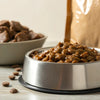Is It OK to Feed My Dog Only Wet Food? A Comprehensive Guide
- Houndsy
Table of Contents
- Introduction
- Understanding Dog Nutrition and Diets
- Pros of Feeding Your Dog Only Wet Food
- Cons of Feeding Your Dog Only Wet Food
- Tips for Transitioning to Wet Food
- FAQs About Feeding Dogs Only Wet Food
- Conclusion
Introduction
Did you know that a significant percentage of dog owners regularly grapple with the decision between wet and dry food? According to various surveys, some estimates suggest that as many as 60% of pet parents often think twice about their canine companion's diet. If you find yourself wondering, is it OK to feed my dog only wet food? you're not alone! This question is becoming increasingly relevant as we delve deeper into pet nutrition.
Feeding our pets is not just a routine task; it's an essential part of responsible pet ownership that significantly impacts their health and happiness. In this post, we'll explore the ins and outs of wet dog food—its benefits, drawbacks, and everything in between. By the end, you'll have a clear understanding of whether wet food is a suitable option for your dog and how to make the best choice tailored to their unique preferences and health needs.
We aim to provide insights that help you reflect on your pet’s feeding practices while sharing knowledge about our flagship product, the Houndsy Kibble Dispenser, designed to create a seamless and beautiful dog-feeding experience. So, grab a cup of your favorite beverage, and let’s embark on this enlightening journey into the world of dog food together!
Understanding Dog Nutrition and Diets
The Basics of Canine Diets
Dogs, being omnivores, can thrive on a variety of diets. However, the foundation of a healthy canine diet primarily hinges on a balanced combination of proteins, fats, carbohydrates, vitamins, and minerals. That's where understanding the choice between wet and dry food becomes crucial:
-
Wet Dog Food: Often comprised of high-quality protein sources, it has a moisture content of 75-80%. Thus, it aids in hydration and often appeals to picky eaters due to its texture and aroma.
-
Dry Dog Food (Kibble): This type is life-sustaining for many dogs, boasting a longer shelf life and affordability. It generally has a lower moisture content, around 10%, and can promote dental health through its crunchy texture.
Why Focus on Wet Food?
The growing popularity of wet food reflects a significant shift in how dog parents view nutrition. Wet food provides hydration, palatability, and a varied texture that appeals to many canines. Additionally, recent research indicates that higher moisture content can benefit urinary health, making it an intriguing option for some pet owners.
Below, we’ll assess the advantages and disadvantages of feeding exclusively wet food and explore whether this might be a beneficial choice for your furry friend.
Pros of Feeding Your Dog Only Wet Food
Enhanced Palatability
One of the standout features of wet dog food is its appeal. The robust aroma and texture can entice even the most discerning canine palates. If you have a fussy eater at home, wet food may spark joy during mealtime, encouraging them to eat without the fuss. When paired with our visually appealing Houndsy Kibble Dispenser, mealtimes can transform into delightful experiences filled with excitement.
Higher Moisture Content
Wet food typically contains 75-80% moisture, which is highly beneficial in promoting hydration. This is particularly advantageous for dogs that do not drink enough water throughout the day. Proper hydration is vital for kidney health and helps avoid urinary tract issues, particularly in senior dogs and those with pre-existing conditions.
Easier to Chew
Wet dog food is generally softer than dry kibble, making it an excellent option for puppies, senior dogs, or those with dental problems. If your dog has dental issues, problematic chewing might deter them from eating altogether. Wet food could facilitate a more enjoyable and problem-free dining experience.
Nutrient-Dense Options
While it's crucial to verify ingredient quality, many wet food brands offer high nutrient density. A balanced diet of wet food can be packed with essential vitamins, minerals, and proteins, ensuring that your dog receives adequate nutrition. Quality options tend to have less filler, making them a more efficient choice for nutrition-focused pet owners.
Ideal for Weight Management
Wet food is often lower in carbohydrates than dry kibble. For dogs that might be struggling with weight management, a wet food diet can support weight loss due to its reduced calorie density while keeping dogs feeling fuller. Always consult with your veterinarian for tailored recommendations when considering this transition.
Cons of Feeding Your Dog Only Wet Food
Increased Cost
One of the primary downsides of a wet food-exclusive diet can be cost. Pricing can add up quickly, especially for larger dogs or multiple dog households. While it’s essential to prioritize quality, evaluate your budget before committing to a wet food-only regimen.
Shorter Shelf Life After Opening
Once opened, wet food spoils relatively quickly—generally lasting around 5-7 days in the refrigerator. This means you might be throwing away food if your dog doesn't finish their meal promptly. Kibble, on the other hand, has a longer shelf life and is easy to keep for extended periods.
Less Convenience
Feeding time with wet food can involve more mess and time consumption than simply scooping kibble. If you are a busy pet owner, you may find it more challenging to manage the cleanliness and timing associated with wet food. Using the Houndsy Kibble Dispenser can certainly help streamline the feeding routine, bringing a touch of elegance to the process.
Dental Health Considerations
Wet food doesn’t provide the same teeth-cleaning benefits as dry kibble. The chewy texture of kibble can help scrape tartar off your dog’s teeth. Pet owners providing exclusively wet food should be diligent about dental hygiene to mitigate potential tartar buildup. Regular dental check-ups and chewing toys can assist in addressing this concern.
Potential for Dietary Imbalance
While many wet food options are nutritionally sound, there are some that may not be. It’s essential to choose high-quality products that comply with AAFCO (Association of American Feed Control Officials) guidelines. Also, avoid brands with excessive fillers or low-quality ingredients to prevent a nutritional imbalance in your dog’s diet.
Tips for Transitioning to Wet Food
Considering a switch? Here’s how to go about it effectively:
-
Gradual Transition: Start by mixing wet food with their current kibble. Gradually increase the proportion of wet food over 5-7 days.
-
Observe Changes: Keep an eye on your dog’s health and behavior during the transition. Note any changes in their appetite or digestion.
-
Consult a Veterinarian: Always touch base with your vet for personalized recommendations based on your dog’s health, age, and lifestyle.
-
Incorporate a Good Feeding Routine: Using our Houndsy Kibble Dispenser makes it easy to maintain a structured feeding routine, ensuring consistent portion control and a clean environment.
FAQs About Feeding Dogs Only Wet Food
Q1: Can I mix wet and dry dog food?
Yes! Mixing both can encourage your dog to try new flavors while still benefiting from the texture and nutrition of dry kibble. Consult with your veterinarian for ideal mixing ratios.
Q2: How often should I feed my dog wet food?
Feeding frequency can depend on factors such as their age, size, and activity level. Generally, adult dogs should be fed two meals per day, while puppies might require three or four smaller meals throughout the day.
Q3: How do I know if my dog is getting enough nutrition?
Always check labels to ensure any food you purchase meets AAFCO standards. Your vet can also provide specific assessments based on your dog's weight, health status, and dietary needs.
Q4: Is it better to feed my dog wet food or dry food?
Both wet and dry food can offer complete nutrition. The best choice depends on your dog's individual needs, preferences, and any specific health considerations.
Q5: What if my dog has digestive issues?
If your dog has a sensitive stomach, it’s vital to select a high-quality wet food that is easy to digest. Speak with your vet about specific brands or types that cater to dietary sensitivities.
Q6: Can I heat up wet dog food?
Yes, warming wet dog food (to body temperature, not hot) can enhance aroma and flavor, making it more appealing to your dog.
Conclusion
In summary, feeding your dog only wet food can be perfectly healthy as long as you choose high-quality options and provide proper portions tailored to your pup's needs. While wet food offers benefits such as hydration, increased palatability, and ease of consumption, it's essential to weigh these against factors like cost and storage.
At Houndsy, we believe that the dog-feeding experience matters. Our Houndsy Kibble Dispenser not only elevates mealtime but also complements your home decor with its mid-century modern design. If you’re considering how to enhance your dog's meal experience, we invite you to explore the Houndsy Kibble Dispenser today! Transform mealtime into a beautiful, smooth routine that both you and your furry friend will cherish.
Ultimately, whatever choice you make regarding your dog's diet, we hope our insights have empowered you to make informed decisions that promote your pet's health and happiness. Remember, a well-fed dog is a happy dog!












